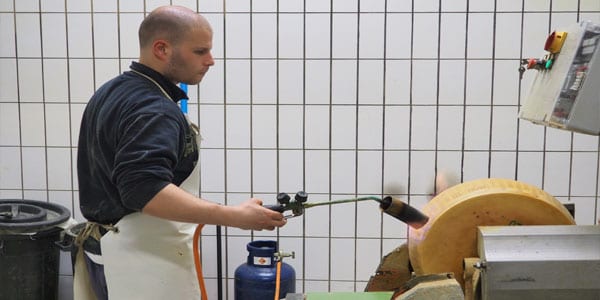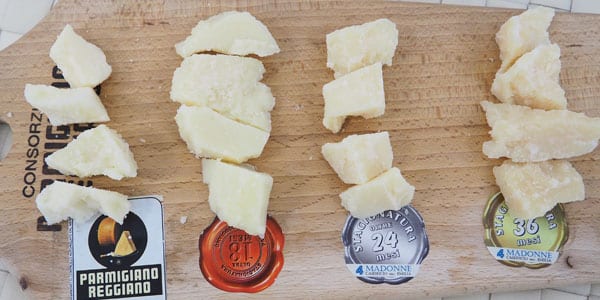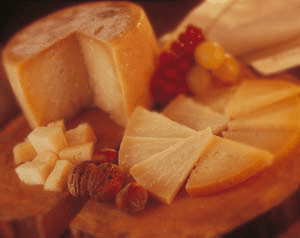Write: Monica Uriel. Journalist
The king of Italian cheeses, Parmigiano Reggiano. It is one of the oldest products in the country and its recipe has remained unchanged for nine centuries. Of course with the same ingredients: raw milk, rennet and salt, totally natural, without additives, and in an artisanal process. As can be seen in the cheese shops. This PDO cheese is made in the provinces of. : Parma, Reggio Emilia, Modena, Bologna and Mantua in an area of 10.000 square kilometers.

Of the 330 dairies, mostly family members, a total of 3.650.563 pieces were released last year. With a total of 147.125 tons, 51.900 of them exported. They were made with milk from 3.000 small cow farms.
For each piece of cheese, weighing 40 kilos, 550 liters of milk are needed. Cows, Friesians, which only feed on forage, hay and cereals - fermented forages are prohibited. They are milked twice a day and the milk that comes out at night is taken to the cheese factory.
A must for cheese lovers
The next morning the cream that has come out is removed and used for the butter. Huge kettles are filled with milk in the morning and a part of that milked at night, made of copper on the inside and steel on the outside.
Like those that can be seen in the visit to the 4 Madonne cheese factory (www.caseificio4madonne.it), just 5 kilometers from Modena. Open since 1967, one of the largest in the area and from which 104 pieces of cheese a day come out.

The experience of making basic Parmigiano cheese
When 36 degrees are reached, the serum from the previous day's preparation is added. Subsequently the rennet from the stomach of the veal, which is left for about 15 minutes. It is always the cheesemaker, who is accompanied by his wife, who decides the temperature and times and who checks with his finger if the curd has formed. Formerly it was made with a thorn.
Then break the rennet into small pieces, the size of rice grains. The smaller the pieces, the longer they can cure.
The curd is cooked at a temperature of 55 degrees and when finished, by the force of gravity, all the grains will drop to the bottom of the boiler. The serum will stay on top. With a large wooden shovel, all the grains that have been compacted will be removed.
To make this cheese, a lot of experience is needed on the part of the cheesemaker since neither the times nor the temperature are fixed. A good part of the production, which is still handmade, is made by hand, they tell us during the visit.
The cheesemaker is traditionally the one that makes the cheese in parallel ricotta cheese with the leftover serum from Parmesan Cheese.

A cheese from the middle ages
The origin of Parmigiano Reggiano goes back to the Middle Ages. When the Benedictine monks began to work in the fields. They found milk and looked for the best way to preserve it. They then began the 'caseification' of the milk by making large pieces so that they could cope with both long periods and transport.
The size of the pieces increased but the recipe and its only three ingredients remain unchanged: raw milk, salt and rennet.
Masses of 100 kilos come out of the boiler, which are divided in two. Each of them will drop to 40 kilos after 12 months. Freshly released 50-kilo pieces are put under pressure on the first day.
Then a mold that will give it its final shape and a plastic around it will record all its data: the year and month of production. An alphanumeric code that will be like your identity card, and your unmistakable name of the cheese written with dots.
The pieces are then put in the salting room. There the cheeses remain with water and salt for 16 days, which is when the salt manages to reach the center of the piece. No preservative is added, only salt.
It is then that the cheeses are taken to a large warehouse at 18 degrees and 80% humidity. In the case of this cheese factory, 30.000 pieces fit. Every 10 days the cheeses, stacked to the ceiling, are turned over and any mold removed.
Quality controls
The name of "Parmigiano Reggiano" written with points is provisional because after 12 months -the minimum curing- the DO experts arrive. They carry out an artisanal control, because with a hammer they hit each cheese to check that there are no problems inside. Thus, the dough must be compact.
Those who pass the control are marked with fire. Otherwise, the name written with dots around the piece is covered in white.

In the market there are: 12 months -the softest and that cannot be grated-, those of 18 months and those of 24 months. The latter is the most widely consumed and most versatile, to take alone or in recipes. Also, tyrosine crystals are found in it. It can be scratched too.
Followed by the Parmesan 36 months, which shows that the cheese has already changed a lot. Difficult to combine, so it is taken alone.
There are cheese factories that are beginning long curing periods of 72 and 80 months. The pieces are sold in pieces and the best-selling pieces are those of one kilo. The rinds of the cheese are also sold, which are used for the Minestrone.






